"Who wants Seconds? "
How often have you heard that question at the dinner table?
Maybe you come from a family eager to dish out seconds, thirds, or even fourths.
Nowhere else on this planet are there more restaurants that promote“All You Can Eat” buffets, “Grand Slam” breakfast meals, or piled-high “MealDeal” combos that could feed a small village in a third world country.Americans demand their food bigger, faster, cheaper and limitless. This attitude is implant- ed in our minds at a young age and it is only getting worse.
Childhood obesity is now almost as endemic as adult obesity. We have to destroy this attitude before it destroys us - our health, economy, and way of life. Calories to Fit Your NeedsThere is no way around it: Calories do count. It doesn’t matter if you’re a low- carb, low fat, or higher protein kind of eater, in the end it always comes down to how much. To maintain weight and stay fit, how much you eat must be equal to or less than what you burn. This is your highest priority and the reason it is principle number one. But as I promised, you won’t have to be a slave to calorie counting.
Though some counting is inevitable, especially in the beginning of a new regimen and when making your own meals, I am going to teach you how to make it a quick mental and visual task, rather than a complicated mathematical calculation.
And you will still enjoy yourself at mealtime. Taste, frequency, and quality will become your new meal planning priorities. You will not eat less often; you will eat more often.I will show you how eating quality calories within a healthy calorie count will keep you satisfied and burning calories all day long. Now before some of you blow off the first of my Three Principles as trite or as old news, let me clarify its importance.
EAT LESS, LIVE LONGER
It is a well known fact that a high-calorie diet containing too many saturated fats is linked to an increased incidence of heart disease. We also know that a high-calorie diet containing too many carbohydrates, especially the simple (sugary) kind, can sometimes lead to diabetes.
Both are life-threatening diseases that can also compromise your quality of life now and in your golden years. There is now documented scientific evidence that any high-calorie diet can limit your very life expectancy. This evidence first came to scientists’ attention during the1980s when they compared the lifespan of two groups of mice. Each day, one group was given a limitless amount of food and the other group was given 40percent less than the “all you can eat” group. This was by no means a starvation or even restricted diet; the mice in the limited food group had plenty of food on which to thrive. In fact, the mice that ate less were healthier, had more energy, and lived 20 percent longer than the other group. Translated into human years, that would be an extra 15 quality, healthy years of life. The mice that were allowed to eat at will not only had shorter lives, but also had a higher incidence of diabetes, cancer, and heart disease. They even had less sex! I don’t know about you, but this really challenged my view of the old saying “fat and happy.” Human and primate studies, as well as statistics from a few unique cultural groups in other countries, confirm the less food/better health phenomenon. Just like any other machine, if we give our bodies too much fuel and stress our parts beyond their original design, something is either going to break or simply wear out sooner than it should.
Watching your caloric intake will not only pay off in your weight management but it will also give you a much better shot at a longer, healthier, and happier life.
A diet focused only on calorie restriction is doomed to fail. When people cut calories to lose weight, they eat too little and view it as a temporary sacrifice with the assumption that eating habits will go back to normal once the weight is lost. They are always hungry and miserable, which adds up to an emotional recipe for failure.I am going to teach you how to figure out your daily caloric needs based on the energy you burn during a day.
There are countless ways to determine your optimal weight, from measurements put out by insurance actuaries, to government pamphlets, to skin calipers, and water immersion tests that calculate body fat. I’ve never been hooked up to a bunch of tubes and dunked in a tank of water and I am assuming that you don’t want to be put through that bother either. You can estimate your daily food intake simply by using your height, age, and gender as factors. Note that I say estimate. You can factor in your activity level or any other personal criteria that can affect the rate at which you burn calories. For example, a waiter in a busy diner will use up more calories than a desk jockey.The following table provides estimates of total daily calories for thirty year old men and women with different heights, weights and activity levels. The chart was developed by the National Institute of Medicine, a panel of scientists and physicians appointed by the U.S.Congress to design daily guidelines for adults to maintain a healthy lifestyle. It is not a weight loss chart, but I like the fact that it provides a range of calories and shows a realistic view of how much the average person can eat daily.
Use these numbers as a starting place and see where your calorie range is.Then use the website to calculate and track your daily calories.Notice that the daily calories for a four foot, eleven inch sedentary woman and an five foot, eleven inch active man only differ by a little under 1,200 calories! It just isn’t necessary for a smaller person to eat a lot less or a larger person to eat a lot more to maintain their goals. Rather than focusing on the exact amount of calories you consume, I want you to find a high and low range for yourself and realize just how easy it is to overdo it and how unnecessary it is to under do it.
Keep in mind that these estimates are based on what men and women can eat to maintain their weight. They are not designed for weight loss. If you are overweight, you either are eating more than the chart recommends, are not active enough to burn the necessary calories, or both. By cutting back calories or eating at maintenance levels, any physical activity will automatically help you lose weight until you arrive at the metabolic equilibrium we call your target weight. It may happen slowly perhaps, but it will happen. This is the healthy way you lose weight and keep it off permanently. At the end of Part 2, I describe two general meal plans. The first is the BOK Fat Loss/Weight Maintenance Meal Plan, which supports the eating strategy just described. The second is the BOK AcceleratedFat Loss Meal Plan, which is a bit more aggressive allowing you to achieve results faster, and is only intended for specific shorter term goals.
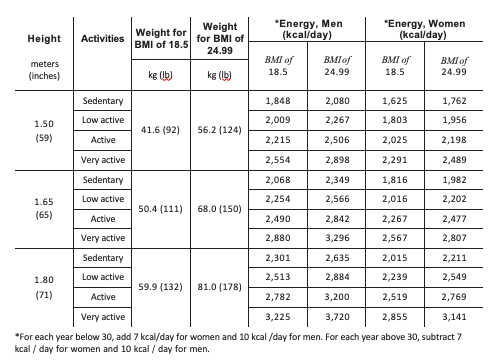
Now that you have a feel for your healthy range of total daily calories, the next step is to determine a correct mix of carbohydrates, protein, and fat. What are the appropriate portions of these three fuels for fat loss, weight maintenance, or just good health? Even though everyone’s daily caloric intake for weight maintenance is a little bit different, all three fuel amounts are determined using the same method of percentages and ratios.
The federal food guidelines issued by the Institute of Medicine of the National Academies, for example, suggest that we get 45 to 55 percent of our daily calories from carbohydrates, 10 to 35 percent from protein, and 20 to 35 percent from fat. This is a far cry from the old recommendations that allowed carbs to reach 70percent and cut off protein at 15 percent. Bravo, Uncle Sam! Like the DRI’s for vitamins and minerals, the federal government issues these numbers as safe and conservative criteria based on the consensus of a panel of experts who use current research to make their recommendations.The weight maintenance percentages in my plan fall within these ranges, and my accelerated fat loss percentages are only slightly different from the government’s recommendations. They are designed to help you lose weight, eat more, and maintain peak health.
My protein percentages in the accelerated fat loss plan are five percent higher than those suggested by the government (well within the safe range, but far less than popular high-protein diets). Protein has fewer calories than fat per gram, so you can automatically lower the amount of total calories you eat per day by switching to this ratio.You can easily cut hundreds of calories without losing a bit of meal satisfaction. For example, cutting out just one tablespoon of oil for your salad or apat of butter for your vegetables saves 110 calories and subtracts nothing from feeling satisfied. Instead, you could consume those same calories by eating three ounces of chicken breast—pure protein that will help satisfy your hunger better and build fat-burn.
You can easily cut hundreds of calories without losing a bit of meal satisfaction.
Combine that protein with some complex carbs and you have the secret formula for minimizing fat production.Here are my two suggested sets of fuel ratios (in grams)and their carbohydrate-to-protein ratios: It’s that simple. You can eat twice as many carbohydrates as protein or equal amounts of these two fuels, depending on which plan you choose. As you will learn later in Part 2, the BOK Six Fuel Groups classification system is based on the ratios from the BOK Fat Loss/WeightMaintenance Meal Plan. Note that the ratios refer to grams. The ratios are a bit different if you are calculating calories, but either way you can have this done for you using the BOK MealPlanner on the website.Please don’t feel chained to these percentages.
Let’s be honest, it is next to impossible to eat exactly by the numbers day-in and day-out. Once in a while you will forget, miscalculate, or totally fall off the wagon. Ultimately, you should adhere to these guidelines to reach your goals, but they do not need to be perfectly matched at every meal. They only need to add up at the end of the day and total up by week’s end. These ratios are a basis for you to develop your own eat-ing habits specific to your own set of goals. I want you to understand them and make them your own, not simply accept them and follow on blind faith alone. Another benefit of these fuel ratios is their inherent ability to help you navigate different or difficult situations.They work beautifully to quickly adjust a diet gone awry. For example, you can quickly correct the unwanted physical effects of a full-blown binge by returning to your percentages or ratios and recommended amount of daily calories. You don’t have to starve yourself the next day if you overindulge; just return to the basics.The same goes for a day when you are fighting fatigue or having a hard time staying focused and your diet goes astray. Give your body the amount of food it needs return to a better food percentage scenario, and select better quality fuels before you reach for that double espresso. How about emotional situation that influences your food choices, such as a bad day at work or an argument with a friend or spouse? Returning to the basic principles will put you back on track and avoid a downward spiral.Just do your best and before long, you’ll be keeping a mental log from meal to meal, tallying up the percentages at the end of the day and you will be able to make intelligent choices quickly.
Sizing Made Simple
If you are looking for a quick and easy visual reference to gauge meal size, just put up your dukes! On average, the inside of your stomach is about the size of your clenched fist after a healthy sized meal and two fists after a large meal. Think of that next time you approach the all-you-can-eat buffet line at a party or restaurant.
The inside of your stomach is about the size of your clenched fist.Meal sizes in this country are out of control. We have become big-meal obsessed, mostly asa result of food chains competing among themselves to serve up the ‘biggest’ bang for the buck – most often unhealthy processed carbohydrates and fat. We have to turn this trend around.So, what is a normal-size serving?
The Simple Serving Size Visual Chart gives you a visual comparison of what is considered“normal” for a few food items. Think of these visual images each time you sit down at a meal to get a realistic idea of what you need to satisfy that fist-sized stomach. Granted, these might seem meager if you are on the typical three-meal-a-day plan, but they are not on my plans, which encourage you to eat far more than three times a day.
The way to lose fat is to eat more often. Principle 2 will explain why and show you how.
Principle No. 2—How Often to Eat
If you eat the traditional three meals a day but continuously think about food, I have good news for you. You are not eating often enough! Think for a moment. When was the last time you ate? If the answer is four, five, or even six hours ago, you are going way too long between meals. I cannot emphasize this enough: How often you eat is tantamount to reaching and maintaining any weight-loss or weight management goals. It is the number one workhorse behind the three principles. It is the key to insulin management, a more stable metabolism, and optimal health.If you want to produce consistent results and avoid the hunger and misery that result from conventional diets, eat smaller portions and eat more frequent-
five to seven meals per day.
Principle No. 2 makes Principle No. 1 attainable and easy to maintain.
Frequent small meals infuse the body with a slow and steady flow of fuels producing wonderful things for the body and mind. Slow and steady keeps insulin and blood sugar levels on an even keel avoiding erratic surges that play havoc with the appetite, dull the brain, and put wear and tear on body systems. Slow and steady keeps the brain (fueled only by carbs) continually fed, helping to maintain mental clarity all day long.Frequent small meals allow us to maintain a higher and more consistent level of protein in the blood, keeping those metabolic engines in our muscles revved up and increasing the rate at which calories are burned. Eating less food more often circumvents hunger and the cravings that ac- company it, making life within a healthy caloric limit a slam-dunk. Eating more frequently is the key to a successful weight loss program because it prevents the typical ‘sometimes’ dieter from quitting. It is also what counts most when it comes to maintaining your hard earned results.
One of the marvels of the body that I mentioned in Part 1 is our ability to store food. It really is incredible, even though most people do not view it as an asset. But think about it: fuel storage is directly related to eating habits for all species.Think of the bear that eats throughout the first three seasons of the year collecting layers of fat. Instead of a burden, the fat storage becomes vital to survival when the bear hibernates all winter. The opposite is true for species like deer or other “grazers.” They eat small meals continuously throughout the day and during all the seasons. So if you are unsure about buying into the idea that eating five or six smaller meals a day promotes weight loss, answer this question: Have you ever seen a fat deer?
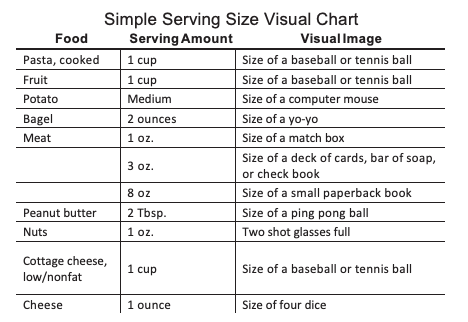
Take an Insulin Ride
When you eat a healthy meal—that is, the right mixture of carbohydrates, protein, and fats in small amounts—insulin works beautifully. As the solid line in the graph below shows, the level of glucose (fuel) in the bloodstream peaks about one hour after ingestion and returns to normal levels within a period of two hours. As glucose enters your bloodstream after a meal, insulin is released right along with it. Insulin is released slowly, rising just enough to direct glucose in the bloodstream into the cells and to regulate the fuel-burning efficiency of the meal you just ate. Insulin rises right along with glucose levels, and together they return to normal levels in about two hours. Let’s take a look at your glucose, or blood sugar levels for a typical three-meal-a-day diet (dashed line) and a seven-meal-a-day diet (solid line). The vertical axis on the graph represents the blood sugar concentration, the bottom horizontal axis on the graph represents time, and the dot- ted line above it represents a normal blood sugar range.
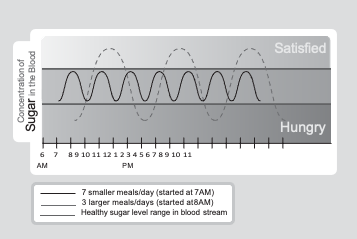
Levels of glucose above the dotted line represent degrees of satisfaction, levels below are degrees of hunger. Notice how a sixteen-hour stretch, the average time awake, could include up to seven meals if eaten every two hours. When we eat three larger meals a day, we spend more time down in the hunger zone; proof that we are going against our natural metabolic needs. As a result, the body wants to hang on to more calories, instinctively protecting itself from the self-induced temporary famine.The graph below shows the two insulin responses. The seven-meal day (solid line) shows virtually no variation in insulin response and maintains a steady, low level of insulin throughout the day. And since insulin is the storage hormone, the lower the insulin level, the more likely it is that fat will be burned, not produced or stored.
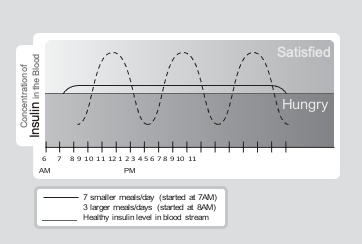
The main reason small frequent meals are such a successful weight loss and weight management tool is because they keep insulin working at a steady pace. And not only will a lower steady level of insulin store less fat, but it will also automatically promote better overall health. Insulin is a life-sustaining hormone that is produced by an organ called the pancreas, where it works as chief liaison to a variety of metabolic events that take place in the body. Primarily, insulin regulates the levels of glucose (sugar) in the blood and is involved in the processes necessary to metabolize, store and burn carbohydrates, protein, and fat. In short, how insulin acts and reacts is directly related to our eating habits. And what it reacts to the most is a big meal, especially one containing a lot of carbohydrates.When we eat a big meal or tease insulin with storage-friendly foods(like simple carbohydrates),the pancreas is pushed into production overdrive, surging the blood stream with abnormally high levels of insulin. When this happens, the body’s fuel-regulating mechanisms run amok. Think of normal insulin secretion as the calm river at the base of the Hoover Dam. What would happen if the dam suddenly broke free? A large meal is like a dam breaking, setting off a tidal wave of insulin causing an overflow of fat storage. Insulin is the molecular key that directs carbs, fat, and protein in the blood into the cells where they will either burn
off as fuel or hibernate in storage. The more we eat, the more insulin is let loose, resulting in greater fuel storage. And if that is not enough to sabotage
High insulin levels… will block your ability to burn fat as well weight loss efforts, high insulin levels hit on fat metabolism directly and will block your ability to burn fat too and bully it back into your fat cells. Give your body more protein and carbohydrates than it can burn and insulin will turn them into fat as well.The bigger the meal, the larger the release of insulin, and the greater the con- sequences.Keep that in mind next time you’re tempted by thoughts of a high- sugar soft drink and bag of cookies while watching your favorite TV program!
Carbohydrates enter the bloodstream faster than protein and fat because they are the only fuel that is broken down as soon as we start chewing (through the action of amylase, an enzyme secreted by the salivary glands). Also, carbohydrates are absorbed into the bloodstream at different rates, quality carbs (the complex kind) being the slowest to flow through. However, a large amount of any carbohydrate will create a rush of insulin, so it is in your best interest to eat your carbs smartly so they trickle in slowly. We’ll explore this more in our discussion of Principle No. 3.Principle No. 2is also important for protein regulation and maintenance. Carbohydrates and fats can be stored in the body and will remain there until they are needed.Protein also has a storage house—our muscles. The difference is that taking protein from storage usually goes against our weight management goals because it means that we are eliminating muscle mass, which affects our metabolic rate(this can lower it). Eating small frequent meals with good quality protein will provide a steady supply of this fuel, which is the best and easiest way to maintain a higher metabolism and ensure that your body doesn’t have to turn to your muscles for the protein it needs to keep burning the other fuels.Keep in mind, though, that total daily calories (Principle No. 1) still dominate weight loss and gain.Meal frequency and insulin levels, however, play the lead in our ability to maintain our ideal weight and health because they operate the controls for fat storage. Bottom line: to discourage fat storage, keep insulin at a consistent low level. That means keeping meal frequency a top priority.
There are two common eating habits thats send insulin levels into the stratosphere: overeating and eating fat storage–friendly foods, such as large quantities of simple and processed carbohydrates. Notice how the dashed line in the graph shown here differs sharply from the solid line. Insulin and blood sugar rise quickly after the large meal, then take a plunge. This infamous “sugar crash” not only takes the curve lower and makes us hungrier than if we had a small meal, but sometimes we can even get hungry again sooner! The result is lethargy, mental fatigue, and even confusion. Unfortunately, the most frequently chosen quick fix is usually eating more carbs—something sweet—and that can start a vicious cycle. And you now know the answer to the question: “How could I eat that slice of pumpkin pie after stuffing myself at Thanksgiving dinner?”
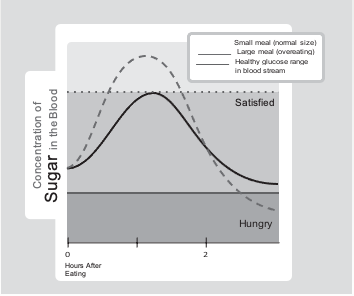
Another perk of eating frequently is the effect that eating small meals has on the stomach itself. We already know that chemical processes (such as blood sugar and insulin release) are affected by our poor eating habits, but there are mechanical processes that also add to our problems. The stomach walls contain special “stretch receptors”that communicate with the satiety center in the brain, the place where we perceive our sense of satisfaction after a meal or feel discomfort from hunger.As food and beverages make their way down the esophagus and to the stomach, the stomach walls are stretched by the amount that enters. As the stomach stretches, the stretch receptors start sending mes- sages to the satiety center. (You can slow down now!) The more food we eat, the stronger the signal and the more satisfied we feel. (Enough, already!) However, it takes about 20 minutes for your food signal from the stretch receptors in your stomach to get to your brain and it’s satiety center. And that’s plenty of time for you to do serious damage at any meal.No doubt you’ve over eaten during the holidays and wondered how you could have eaten so much, right?Well, it’s because your brain was operating on a lack of information. While you were enjoying the taste of your meal (a signal that reaches your brain almost instantaneously), your brain was still thinking.
It takes about 20 minutes for your food signal …
to get to your brain.your stomach was empty. We are able to eat heaping plates of food like ravenous piranhas because the brain doesn’t know that the stomach is full yet. Just relax. Eat slowly, chew your food completely, and take short breaks. This way, even the smallest of meals can last longer and give you complete satisfaction.
Gauging portion size is simple if you remember that your stomach is about the size of your fist. And that is the amount of food that it will take to satisfy you.Three-meal-a-day eaters often down the equivalent of two to three fist fulls. It is the feeling of fullness to which they have become accustomed. The stomach has an average maximum capacity of approximately 1.5 liters—3 1/2 pounds! Eating large meals only 2 – 3 times a day, everyday, is a big problem because eventually it stretches the stomach to the point where it stays at its new, larger size.
This actually resets the stretch receptors so that they send that full feeling to the satiety center only after a larger volume of food hits the stomach.As the walls of the stomach are stretched, we become less sensitive to the “fullness” signal. You end up needing more food —more calories—to feel full!The good news is that for most of us the stomach stretch receptors are very elastic and can snap back over time.Just cut back on your meal size. Eating small, more frequent meals can gradually bring down the stretch threshold and allow the stomach to shrink back to its smallest size, about two ounces (between meals). Your smaller stomach size will guarantee a feeling of satisfaction after a small meal, especially if you allow 20 minutes for meal time which will allow your brain to register that you’ve had enough. Be aware though, that there are other influences on our sense of satiety.
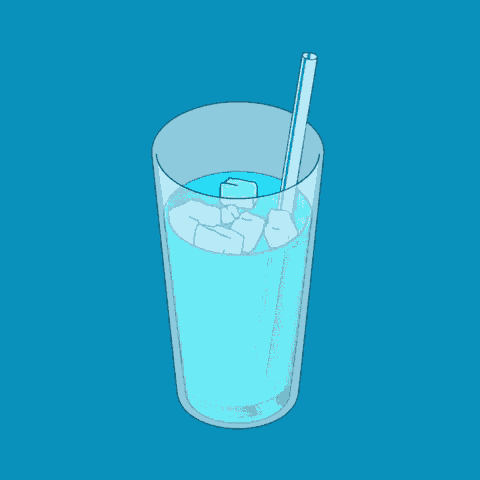
THIRST MASQUERADING AS HUNGER IN DISGUISE
You are probably familiar with the long-standing diet tip that says you should drink water before, during, and after a meal to help you “feel full.” This isn’t just a gimmick. There is another genuine, though little-known, scientific explanation behind it. If you go back to high school science, you’ll remember that osmosisis is simply the process of water or other substances moving across a barrier, such as a cell wall. Food and other particles, especially salt, draw water out of tissues in your body and into the blood stream immediately after a meal. This process happens in all cells, including the ones in your brain. It affects thirst primarily, but also hunger.
After a meal, food in your bloodstream pulls water out of your cells—sensitive cells like the ones in your satiety center. The areas for thirst and hunger are very close in our satiety center so the strong thirst signal we receive after a meal (especially a large one) can also affect the hunger center. Our craving for water can be confused with a craving for more food. When you feel the need for a second helping, drink a glass or two of water instead. Most likely, it is water, not food that your body is craving. In fact, make sure that you always drink a glass of water or other drink that is mostly water before, during, and after every meal. Your thirst will not only stop masquerading as hunger, but the volume of water already in your stomach will help you eat less.
Now let’s take a look at real-life food requirements, starting with the moment you smack the snooze button on your alarm clock at 7 a.m. You yawn, stretch, and rub your stomach which feels a little empty from your overnight fast. Your body needs energy, though it has probably liberated some of your stored carbo- hydrates during the night. As a result, you may not feel hungry right away. Sometime within the next half-hour to an hour, you feel a little pang. You are ready for your first meal. It should be a small meal because after six to eight hours without food your stomach is at its smallest (and when stretch receptors are most sensitive). You’re out the door and on the road a little after 8 a.m.Hopefully, you did not leave home without your morning snack that, calorie- wise, should be about the same size as or slightly larger than your breakfast.
You start to nibble on it at about 10:30a.m.
At noon or shortly thereafter, you are ready for lunch. Then at about 3 or4 p.m., it is time for food again—just a small snack, about the size of your breakfast or morning snack. At 5:30 p.m., still feeling satisfied from your mid-day snack, you head home to prepare dinner. Calorie-wise it should be close to or slightly less than the size of your lunch. Or, if you were still quite full from your afternoon snack, you may have decided to have a light dinner. If that was the case, two hours before bedtime, at about 9 p.m.,you may feel hunger returning so you have another small healthy snack or nibble on leftovers from dinner, still being careful not to exceed your total daily calorie requirements. You’re off to dreamland right after the 10 p.m. news and before you feel your sugar levels drop to avoid the infamous “midnight snack.”
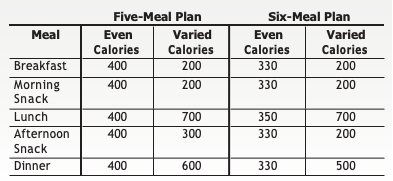
Portion Reapportionment
Do you habitually eat until you can’t eat any more? To break this habit, I suggest you visually and physically divide the meal you are about to eat into four equal parts.Eat each portion at your regular rate and then wait two-to-five minutes before starting on the next portion. Don’t, however, just sit there and stare at your food! Converse with a dinner partner, read your mail, page through a magazine or surf the internet. This will give the satiety center in your brain plenty of time to send signals to the stretch receptors in your stomach that you’ve had enough to eat. Gradually you will feel satisfied eating less food.To illustrate how this measures out, let’s use as an example of an active woman on a 2,000-calories-a-day diet. She could divide her calories evenly throughout the day (but most of us by nature are not that robotic) or she could vary them, as demonstrated below. Her caloric in take during the day would look like the chart above:
Have I convinced you that small, more frequent meals are the way to go? Good. I cannot emphasize enough how important this step is to your weight management goals.Equally important is your timing between meals.
Remember, the normal rise and fall of both insulin and blood sugar in response to eating is about two hours. As long as you wait at least this amount of time and no more than three hours to eat your next meal, your insulin and blood sugar levels will remain optimal— that is, most consistent for weight loss and maintenance.
Your life-long mission will now be to eat smaller meals five-to-seven times a day, about every two to three hours in the typical 16-hour waking day.
You will eat like this for four important reasons:
1. to avoid the overproduction of insulin and high blood sugar levels.
2. to avoid the hunger-promoting “sugar crash,” the inevitable drop in blood sugar that occurs when we overeat
3. to enhance the eating experience and avoid hunger pangs
4. to put our body in fat-burning mode and keep it out of fat-storing mode
Next comes the most commonly asked question: What, exactly, is someone supposed to eat in those five-to-seven meals a day? The answer is the right mix of carbohydrates, protein, and fat to help fine-tune your fat-burning capabilities throughout the day, as described in Principle No. 3.
Over the years I have experimented with countless diet plans and different eating habits. I have found that no matter how “revolutionary” or “new” a diet claims to be, you just can’t hide from Mother Nature or the laws of physics. Mother Nature is a brilliant planner. She has provided us with natural food sources that will not only keep us alive, but make us thrive. Her foods are abundantly rich in the essential nutrients that keep our machines well-maintained and running 24 hours a day.
It is no coincidence that nearly all the foods that exist in nature contain some amount of the three essential fuels:carbohydrates, protein, or fat. If it were up to Mother Nature, we’d all be lean, mean human machines because we’d eat these fuels instinctively according to her rules! Unfortunately, somewhere in the middle of the 20th Century, an abundance of food production pulled a coup onMother Nature. It started to infiltrate the country with “well-meaning” innovations such as fast food, all-you-can-eat buffets, he-man helpings, meal deals, and “kids eat free” offers, just to name a few. Common code words started appearing like “processed,” “convenience,” “pre-packaged,” and “free refills.” Like lemmings, we followed them right to the checkout counter.
By the end of the century, America became the most over fed and fattest nation in the world. It is time to go back and reclaim Mother Nature’s good intentions.
The Naked Truth
Although poor food quality and processing are at the heart of our bad eating habits, there are other factors at work. We have also fallen prey to temptation and great advertising. Plus, these unhealthy foods provide ease and convenience that take the edge off a fast-paced life. Oh, yes, and there is the taste.
A lot of this stuff tastes pretty good (you’ll find out why as you keep reading). Even the federal government has noticed the errors in our food selection and is trying in its own bureaucratic way to steer us back in the right direction. Four times since 1956 the government has issued official government endorsed food standards. It started by implementing the Basic Four Food Groups, the four equal squares representing grains, meats, dairy, and fruits and vegetables.Progressively, recommendations have changed, now offering the U.S. Department of Agriculture Food GuidePyramid. Surely you have seen it hundreds of times - the pyramid with bread, cereal, rice, and pasta on the bottom; fruits and vegetables in the section above; milk, yogurt, cheese, meat, poultry, fish, eggs, nuts, and dry beans just below the top; and finally fat and sweets at the tip.While it is useful, it does not help us select food according to fuel content. Not all foods in each food group are composed of the same fuels and they do not have the same physical effects once they enter your body. In short, the present food classification system does nothing to answer the big question:
How does one make food choices based on the quality and mixture of fuels that can best manage our health and weight?
The BOK Six Fuel Groups to helps address this problem. It is a dual-action information tool that will help you achieve your weight management goals and attain optimum health at the same time. It measures and breaks down all foods according to their protein, carbohydrate, and fat content, to give you a quick read on what you are about to pop into your mouth at mealtime.
This classification system is designed to complement the knowledge you have already gained from the quantitative Principles No.1 and No. 2. Principle No.3 is the qualitative fine-tuning that is necessary for permanent weight loss, weight maintenance, optimum health, and productive longevity.It is the same classification system that I developed using my own body as a guinea pig over the years. It took trial and error, but I can tell you (and so can the other people who have used it) that it does exactly what it is designed to do – make you aware of what you put into your body.

